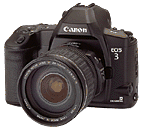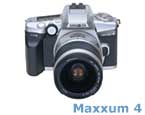A few notes on camera requirements
for Photo I
Many students have concerns about
what type of camera is required for the course. The simple answer to this
question is that you must have a 35mm Single Lens Reflex
camera which permits manual control of the camera's shutter and aperture.
This means that simple "point
and shoot" cameras will not be acceptable. You can do a great deal with
a "point and shoot" camera but it does not permit you to vary aperture
and shutter to control exposure and image properties in your photographs.
The simplest example of a "point and shoot" cameras (also called
"fixed focus") are the paper throw away cameras now available in
stores.


Single Lens Reflex
cameras or SLR's come in many different styles from many different manufacturers.
The most important information for your camera is contained in its User
Guide. Be certain to bring this guide with you when you come to class.
You may be using an older style camera such as the one illustrated below:
If you are using an older model
camera please be certain to check that it is in good working order before
coming to class. It is not uncommon for someone to bring an older model camera
to class expecting that it will work even though it has been stored in a closet
for many years. Cameras whcih sit idle may not function properly. In order
to check your camera you should do the following:
A. Have the batteries tested to
make sure that they are in good shape. At the same time make certain that
your battery terminals are clean. You may want to take the batteries out of
the camera and have them checked at a local camera store - or you may want
to take your whole camera with you.
B. Check to make certain that all
the mechanisms on the camera are in good working order. Look for loose screws,
broken buttons, etc. If you discover any potential problems take your camera
to a local camera store and ask about the costs of repair.
WARNING:
Be cautious about turning in your camera for repair without a written estimate
of repair costs and a written assurance of when the repair will be completed
and the camera returned to you.
C. One of the best ways to test
your camera is to actually use it. Try shooting a short roll of film and have
it developed to be certain that all aspects of your camera are in good order.
To minimize this cost you may ask to only have the film developed and not
printed. Your actual negatives should allow you to determine if your camera
is functioning properly.
There are qualified camera repair
people in the vicinity of Saint Mary's College (please go to the bottom of
the Course Outline) but it would be best if your camera was ready to go when
you arrived on campus for classes.
Be certain that your camera permits
you to control the aperture and shutter of your camera. An all automatic camera
will NOT permit you to do this. You may need to check your user guide to determine
this. It may also be determined by looking for shutter and aperture controls
on the camera itself. An example of each is presented below:


The left image is of a shutter
controller on an older model camera . The image on the right is the aperture
selection ring on the lens of the camera.
More contemporary cameras are almost
entirely electronic. If you are buying as camera for this course please be
careful to determine whether it allows for manual setting of shutter and aperture.
These cameras frequently do not have mechanical controllers for shutter and
aperture. Instead these controls are generally accessed through a small "LCD"
screen on the camera. Example of this type of camera are pictured below:








